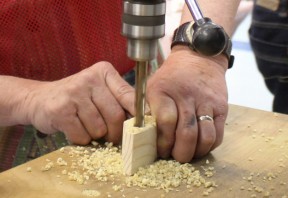Drilling is boring
This week’s lesson in woodworking was a little low key. I hunkered down to get caught up in my drafting. I made some headway and I think I’ll be able to start making some sawdust next week. It will be my first real assignment: build a frame, with an added rail in the middle, using a variety of joints. It doesn’t sound too glamorous, but I’m sure I’ll build some solid skills.
When I wasn’t hunched over the t-square, I was learning about drills and a bit about screws. The shop is stocked mostly with #6 and #8 Robertson screws, sensible and patriotic. When using screws to join two pieces of wood, always predrill. Always. This didn’t come as a surprise to me, but the idea of drilling a clearance hole was new. I would assume you make your pilot holes the diameter of the screw, minus the width of the thread, giving the screw space to enter the wood and the threads something to hold onto. But, driving a screw into such an arrangement can actually create a gap between the two pieces. The solution: drill a clearance hole the diameter of the screw, including the thread, in the piece in which the screw head will sit. So, the threads only dig into the bottom workpiece. The screw head (which is countersunk, of course) pulls everything together tightly.
When boring a hole, don’t simply press down on the drill. Make sure to pull the drill back frequently so the flutes in the bit can pull the waste out of the hole. If you are drilling a deep hole and don’t clear out the waste periodically, you will make drilling more difficult for yourself and possibly cause some burning.
How do you make sure do don’t drill too deeply into a piece of wood? Easy. Mark the depth on the drill bit with a piece of tape. When you attach that piece of tape to the bit, give it a generous tail, which will flap around and clear some sawdust for you, as well as make it easier to remove later.
Over at the drillpress, remember, you are limited by the size of the machine, which is expressed as twice the distance between the chuck and the column. So, don’t plan on boring a hole at the centre of an 18”-wide panel if you have a 16” drillpress, which only has 8” of clearance between the chuck and the column.
A drillpress has multiple speeds, which are set with a belt that runs between two pulleys. Use the lowest speed for bits that need a lot of torque, such as Forstner bits. You can move the belt from disc to disc on each pulley by turning one pulley by hand and using your other to push the belt up or down like a bike’s front derailleur.
And, always take the chuck key out of the chuck before starting the drillpress. I hear it really, really hurts when the key flies off the chuck at you.
To leave a comment, please log in













No comments